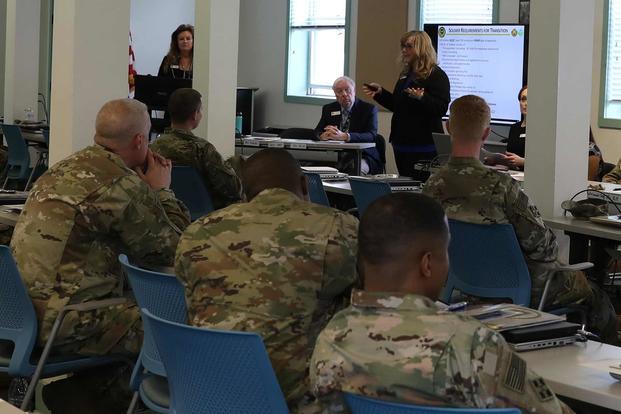The opinions expressed in this op-ed are those of the author and do not necessarily reflect the views of Military.com. If you would like to submit your own commentary, please send your article to opinions@military.com for consideration.
When large-scale military problems need fixing, solutions often come in the form of Band-Aids.
High-profile reports on veteran suicide, homelessness, incarceration and depression have tightened the coil, leaving many veterans service organizations, politicians and federal agencies ready to spring into (re)action. In 2020, a handful of veteran service organizations hope to enter the ring to take on the Transition Assistance Program (TAP), to offer transitioning service members more than a resume, to bring them Boot Camp Out.
But is new better, or just new?
Too Much but Not Enough
“The military is really good at creating new neural pathways to make you into somebody other than you were before you came into the military. They don’t do anything to create new neural pathways for when you leave,” said combat veteran Ron Self. “So, you’re essentially this new person, this new identity going into a world that you have not technically been a part of as the person you are now.”
Self, in addition to serving in the Marine Corps, served time in San Quentin State Prison. While incarcerated, he founded Veterans Healing Veterans from the Inside Out (VHV) in 2012. He said he is working on a pilot program for the Marine Corps that would integrate peer-to-peer counseling, narration therapy, yoga and mindfulness, alongside the more traditional resume writing and financial planning component of the existing TAP curriculum. His “Boot Camp Out” program would be mandatory, accompanied by written orders, and seeks to dismantle the status quo.
Self’s proposal would mirror one he created for inmates and entail “scrapping that [TAP] model and creating an entire new [program] that actually serves the purpose that is supposed to be intended for the veterans, not waste a bunch of the taxpayers' money on jobs and positions that aren’t really doing anything for veterans.”
According to Self, without a program like Boot Camp Out, the military is essentially bringing a tank back from a combat zone, painting it yellow and calling it a school bus. It is a weapon of war; so is the veteran. Not addressing this head-on during the military-civilian transition puts service members and everyone they encounter at risk.
Moral Injury
Self is not the only person to suggest a Boot Camp Out-style strategy. Dr. Rita Brock is the director of the Shay Moral Injury Center at Volunteers of America, a faith-based nonprofit organization. Volunteers of America has run successful pilot programs for veterans that focused on peer-led Resilient Strength Training (RST). Brock, in partnership with Duke University, is in the early stages of developing a similar program to reach active-duty members before their transition.
One of the chief complaints about current programming is its tendency to drown participants with information in a short period of time, by forcing them to drink from the proverbial fire hose. Unlike Self, Brock believes that these holistic-style programs would not have to replace TAP, but rather supplement them.
“Even just two weeks of this … it would make a huge difference and save the Department of Veterans Affairs mental health budget huge amounts of money,” said Brock. However, this is not a VA decision.
Too Big to Succeed?
Currently, transition programming is developed by a government body comprised of the Departments of Defense, Labor, Veterans Affairs, Homeland Security and Education, as well as the Office of Personnel Management and the U.S. Small Business Administration. With a cacophony of voices emphasizing a broad spectrum of perspectives, it is no wonder that there are so many nonprofits looking to fill the perceived gaps in care.
In a November interview, former VA Secretary David Shulkin, who served under both the Obama and Trump administrations, noted a general lack of direction at the highest levels. “[We] can’t just be a meeting for the sake of meeting. There needs to be goals and objectives and targets set so that the outcomes of those joint meetings turn out to be meaningful.”
During Shulkin’s time as VA secretary, he strove to make decisions that produced measurable action items. However, his tenure was cut short after he was fired by President Donald Trump via tweet in March 2018.
“I was starting to pursue how to put some meat around how we were going to do that [strengthening the military-veteran transition],” Shulkin said. “I very much believed in the peer support model. … When you take the pairing of the [VA] peer support network and the reverse boot camp concept, that is where I was driving and that is one of those unfinished tasks I felt regret for not being able to see move forward."
Where Is TAP?
For years, departing service members have had to meet a 90-day regulatory deadline for TAP completion. However, only 46.7 percent of those who completed the program completed it before the 90-day deadline. While military leadership ensured that the TAP box was checked, the message was clear: TAP was an afterthought.
As a result the Government Accountability Office published a report in 2017 emphasizing the need to improve TAP's performance reporting. Congress responded by requiring strict reporting mandates and improved processes in the fiscal 2019 National Defense Authorization Act. Less than two years after the GAO report was published, TAP began implementing changes that took effect Oct. 1, 2019.
With a new completion deadline, one-on-one counseling sessions and customizable training plans, the fisca 2019 legislation seeks to change the perception of the program. The focus of TAP in 2020 “is to solidify the warm handoff process [TAP to VA]. We know that we are getting them connected to resources. What we cannot substantiate is that the service is provided. We believe that it’s happening, and we get anecdotal stories of it happening,” said Tamre Newton, director of the Transition to Veterans Program Office.
Rather than reacting to problems by creating yet another program, TAP hopes to strengthen the existing program structures and allow individual service branches to customize the program to meet the unique needs of their respective departments.
Personal Accountability
Patients lie to doctors. In the military, service members withhold information to avoid being medically discharged. They lie about their mental health to avoid stigma or being disqualified from future positions that prohibit those with PTSD from applying. While it is clear that lying is dangerous for both the service member and those around them, many feel they have no choice but to hide perceived weakness.
Upon discharge, Army veteran Quentin Bennett struggled with homelessness, PTSD, hearing voices, hallucinations, panic attacks and paranoia. Like many who suffer from mental health issues, Bennett was adrift, couch surfing, barely getting by -- not knowing where to turn. When he eventually received treatment at his local VA hospital, he admitted, “They asked me if I heard voices. I lied right away. ...The doctors I worked with did such a great job. They said it was OK. They knew what was going on before I was ready to admit to it.”
If TAP cannot find a way to improve confidence in the program and buy-in from service branches, military leaders and service members themselves, regulatory improvements may not be enough to make the intended impact on the lives of individuals post-service.
Where Do We Go from Here?
Veterans need more than a Band-Aid. They need a champion before, during and after transitioning, coupled with a healthy dose of personal accountability. The problems are clear. Proposed solutions are abundant. What is unclear is who is ultimately responsible for the active-duty to veteran transition.














